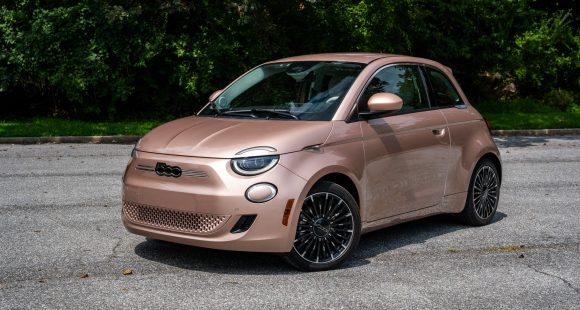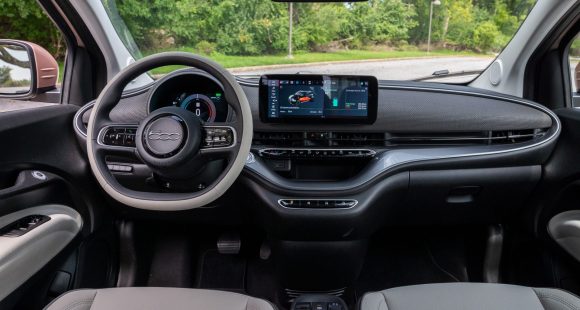2017 Ford Explorer
Since it first arrived for 1991, the Ford Explorer has been a top seller among larger SUV’s and crossovers, with over 7 million sales to date. But, the market for three-row family utilities is bigger and more cut-throat than ever. So, the latest Explorer is outfitted with lot of little changes that Ford hopes will bring big results, with less exploring and more conquering.
2016 marked the 25th anniversary for the Ford Explorer. And while it was far from the first SUV, it was clearly one of the first that made a case for being a family vehicle more than just a rutted roads runabout.
Today’s Explorer bears little resemblance to that truck-based original, now riding on a three row crossover platform that debuted for 2011. Styling updates for ’16 included more than just the usual front fascia; as hood, headlamps, and fenders were new as well.
Most everything got freshened in back also; lift gate, bumper, and taillights. And of course there’s some new wheel styles to choose from. 20-17 adds a Sports Appearance Package with 20-inch wheels and Magnetic Grey highlights for the XLT trim.
 A straightforward 3.5-liter naturally-aspirated V6 is still the base engine. More entertaining is this twin-turbo EcoBoost 3.5-liter V6 with 365-horsepower and 350 lb-ft. of torque.
A straightforward 3.5-liter naturally-aspirated V6 is still the base engine. More entertaining is this twin-turbo EcoBoost 3.5-liter V6 with 365-horsepower and 350 lb-ft. of torque.
The newest option, is the Mustang’s 280-horsepower 2.3-liter I4 EcoBoost that replaces the 2.0-liter.
If your budget is not restricted, by all means opt for the 3.5 EcoBoost. It makes the Explorer feel like a true performance-style SUV. Though all engines offer adequate power as well as all-wheel-drive; and come equipped with a 6-speed automatic transmission. Max towing is a class-norm 5,000-lbs.
The all-wheel-drive system features Ford’s Terrain Management System with settings for Normal, Snow, Sand, and Mud. In our experience, you pick your road conditions and the Explorer responds.
Now, there seems to be no limit to how far manufacturers will go to add poshness to utilities, nor buyers’ appetites for same. So, Ford brings the Platinum series to the Explorer. It features real wood and aluminum trim, as well as premium Sony sound and quilted leather.
And it’s altogether very nice, almost Land rover spec. inside. The brushed aluminum accents are gorgeous, and the animal hides are Nirvana leather, but think more of the place you want to spend eternity in, not the alternative rock band playing right now on Lithium.
 7–passenger seating is standard, with 2nd row Captain’s chairs, an option.
7–passenger seating is standard, with 2nd row Captain’s chairs, an option.
Being one of the larger 3-row crossovers means that cargo space fairs well at 21.0 cubic-ft. behind the 3rd row, 43.9 behind the 2nd row, and maxing out at 81.7 cubic-ft. A hands free lift gate is available with XLT and Sport trim; standard on Limited and Platinum.
Platinum trim also includes enhanced Active Park Assist; and on the safety front, inflatable 2nd row safety belts are now available on all models.
As before, the Explorer won’t yet apply the brakes for you if a collision is imminent; but it will give plenty of warning, and provide full braking pressure once you initiate the stop.
Turbocharging may not me a total replacement for displacement, but our twin-turbo V6 felt plenty V8-strong at our test track. There’s good torque down low, and grippy all-wheel-drive hookup, for a 6.5-second sprint to 60.
There was plenty of high-end grunt as well, accompanied by urgent shifting from the 6-speed automatic; taking us to the end of the ¼-mile in 15.0-seconds flat, at 94 miles-per-hour.
Through the cones, the Explorer still feels big and heavy compared to its many more nimble rivals. But there are still plenty of people out there who want their Bronco-type vehicle to still feel like a truck.
 It’s certainly manageable, though. Just keep the speeds down and your inputs smooth.
It’s certainly manageable, though. Just keep the speeds down and your inputs smooth.
Despite that big-truck feel, a 121-foot average stopping distance from 60 is quite good for any family-size utility. Nose dive was moderate, with pedal travel on the long side.
Government Fuel Economy Ratings for the EcoBoost V6 with all-wheel-drive are 16-City, 22-Highway, and 18-Combined. Our average with Regular grade was right on, at 18.1 miles-per-gallon. That makes for a poor Energy Impact Score at 18.3-barrels of yearly oil consumption with 8.2-tons of CO2 emissions.
There’s a wide variety in pricing, as you might expect, starting at $32,105 for a base 2017 Explorer; all-wheel-drive adds $2,150 more. While Platinum trim comes with a tag befitting the name, at $54,180
Even after a quarter of a century, Ford has managed to find ways to significantly improve the Explorer without any turnoffs. The luxury intentions of the Platinum are obvious, while the rest of the lineup still plays the large family vehicle part perfectly. We think that will keep Explorer’s market-conquering ways intact beyond the horizon.
Specifications
- Engine: 3.5 liter
- Horsepower: 365
- Torque: 350 lb-ft.
- 0-60 mph: 6.5 seconds
- 1/4 mile: 15.0 seconds @ 94 mph
- EPA: 16 mpg city / 22 mpg highway,
- Energy Impact: 18.3 barrels of oil/yr
- CO2 Emissions: 8.2 tons/yr
2024 Fiat 500e
Fiat’s Electric Car Is Also Fiat’s Only Car
EVs are coming in all shapes and sizes these days, but few have a more recognizable shape than this pint-sized Fiat 500e. After all, it first arrived on our shores more than a decade ago. Well, much has changed since then, and there’s an all-new, second-gen 500e now hitting the streets. So, let’s see if it can keep the Fiat brand relevant here in the U.S.
Fiat returned to the U.S. for 2012 with the cute and subcompact 500. Their lineup quickly expanded with several 500-based models, including the all-electric 500e. They even launched a Mazda Miata-based roadster, the 124 Spider. Who would have thought that 12 years on, the only one left would be that 500e? For 2024, it kicks off its 2nd generation here.
At least they left us with not just any 500e, but a La Prima 500e. According to Fiat, it is “Inspired by Beauty,” as one of four trims initially available. There’s also Inspired by Music, Inspired by Los Angeles, and (RED), in parentheses, representing Fiat’s commitment to helping fight global health emergencies. A Giorgio Armani Collector’s Edition is due in 2025.
Our Inspired by Beauty 500e came painted in Rose Gold, which we have to admit may not be beautiful to everyone. But, have no fear, there are plenty of other colors available, one of which we will be adding soon to our long-term test fleet. We actually love most everything else about the exterior of this charming character, boldly showcasing its Italian flair while bringing iconic 500e style and classic proportions to the electrified era.
And it’s quite fun to drive too. Not exactly on the MINI Cooper level, but it certainly has some of that go-kart vibe, with lots of weight down low in its wide and short platform along with quick steering that has you wanting to dart in and around traffic. There’s no lack of safety and convenience features packed into this tiny package. Automatic Emergency Braking and Lane Keep Assist are standard, and inside you’ll find plenty of charge ports and even wireless device charging and integration. There’s also some fine stitch work and subtle reminders of its provenance. Front seats are plenty spacious for even large adults. The rear seats? Well, except for little ones, you’d best just fold them down for added cargo room and think of this as a two-seater hatchback.
Light steering and minimal understeer had us zipping in and out of cones with ease, with the kind of playfulness and toss-ability you can only get in a small car.
The 500e’s single 87-kW motor powers its front wheels to the tune of 117 horsepower and 162 lb-ft of torque. A 42-kWh battery charges at a max rate of 85 kW, getting you to 80% in 35 minutes on DC fast charging; but charging to 100% on Level 2 only takes 6 hours, so you can easily charge it overnight at home. The 500e’s maximum driving range is rated at 149 miles, but with all-season tires it drops to 141. Not to worry, as we were on pace for 174 miles in our driving loop. And using just 29 kWh of electricity per 100 miles, the 500e is quite efficient.
It’s not fast by EV standards, but quicker than most combustion engine subcompacts, even spinning up the tires quite a bit at our Mason Dixon test track. We got to 60 in a pretty quick 7.9 seconds; but that was also where things started to taper off. Speedometer numbers were definitely building less quickly towards the end of the quarter-mile, but for a tiny car it felt plenty smooth and stable down the track. We finished the quarter-mile in 16.2 seconds at 84 mph. There are three drive modes including “Range,” where regenerative braking allows for smooth one-pedal driving.
The 500e felt even better in our handling course, light steering and minimal understeer had us zipping in and out of cones with ease, with the kind of playfulness and toss-ability you can only get in a small car. We found we could push incredibly hard before there was any intervention from stability systems. The only things less than perfect were a touch too much body roll, and the lack of bolstering in the seats to keep us from sliding around. Coming in just under 3,000 lbs., the 500e weighs less than many ICE cars on the road. And that was evident in our braking test, where distance averaged a short 99 feet; stops were straight, fade free, and with very little nosedive.
Perhaps the most gorgeous thing of all about this new 500e is its price tag before incentives, starting with the (RED) at $34,095; from there, Inspired by Beauty, Music, and Los Angeles all have unique features, and all sticker for $37,595. That’s an inviting on-ramp to the EV lifestyle highway, especially if you can catch a cheap lease, though with the limited amount of driving range we wouldn’t stay on there for too long.
But that just means the Fiat 500e is perfectly suited for city dwellers, short distance commuters, and anyone looking for a second car for daily errands that quickly “fills-up” at home every night. Everyone should make room for a little Italian flair in their life, and that’s the Fiat 500e– equal parts charming, quirky, and fun.
Specifications
As Tested
- Motor Setup: Single 87-kW Motor
- Battery Size: 42-kWh
- Horsepower: 117
- Torque: 162 lb-ft
- EPA Range: up to 149 miles
- 0-60 mph: 7.9 seconds
- 1/4 Mile: 16.2 seconds at 84 mph
- Braking, 60-0 (avg.): 99 feet
- MW Test Loop: ~ 174 miles
- Efficiency: 29 kWh / 100 miles











































